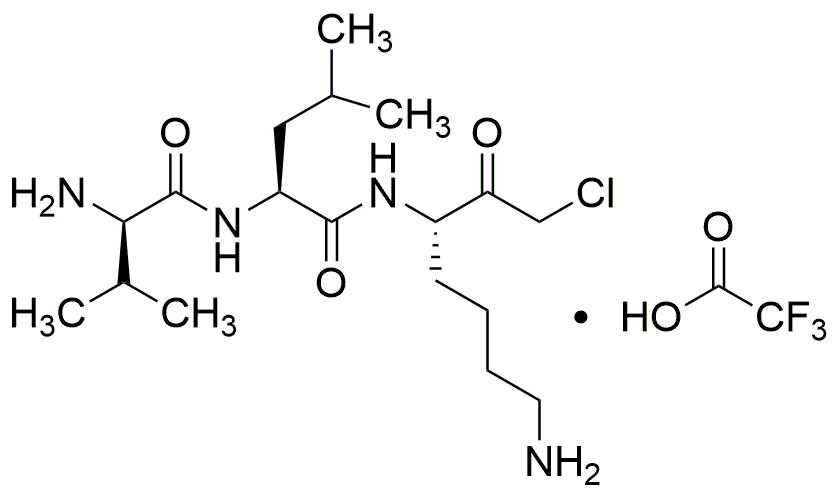D-Val-Leu-Lys-CMK·TFA is widely utilized in research focused on:
- Peptide Synthesis: This compound serves as a valuable reagent in the synthesis of peptides, particularly in creating specific sequences for therapeutic applications.
- Drug Development: It plays a crucial role in the development of protease inhibitors, which are essential in treating various diseases, including viral infections and cancer.
- Biochemical Research: Researchers use it to study enzyme activity and protein interactions, helping to elucidate biological pathways and mechanisms.
- Diagnostics: This compound can be utilized in the design of diagnostic tools that detect specific proteins or enzymes, enhancing disease detection methods.
- Pharmaceutical Formulations: It is incorporated into formulations to improve the stability and efficacy of active pharmaceutical ingredients, ensuring better patient outcomes.
General Information
Properties
Safety and Regulations
Applications
D-Val-Leu-Lys-CMK·TFA is widely utilized in research focused on:
- Peptide Synthesis: This compound serves as a valuable reagent in the synthesis of peptides, particularly in creating specific sequences for therapeutic applications.
- Drug Development: It plays a crucial role in the development of protease inhibitors, which are essential in treating various diseases, including viral infections and cancer.
- Biochemical Research: Researchers use it to study enzyme activity and protein interactions, helping to elucidate biological pathways and mechanisms.
- Diagnostics: This compound can be utilized in the design of diagnostic tools that detect specific proteins or enzymes, enhancing disease detection methods.
- Pharmaceutical Formulations: It is incorporated into formulations to improve the stability and efficacy of active pharmaceutical ingredients, ensuring better patient outcomes.
Documents
Safety Data Sheets (SDS)
The SDS provides comprehensive safety information on handling, storage, and disposal of the product.
Product Specification (PS)
The PS provides a comprehensive breakdown of the product’s properties, including chemical composition, physical state, purity, and storage requirements. It also details acceptable quality ranges and the product's intended applications.
Certificates of Analysis (COA)
Search for Certificates of Analysis (COA) by entering the products Lot Number. Lot and Batch Numbers can be found on a product’s label following the words ‘Lot’ or ‘Batch’.
*Catalog Number
*Lot Number
Certificates Of Origin (COO)
This COO confirms the country where the product was manufactured, and also details the materials and components used in it and whether it is derived from natural, synthetic, or other specific sources. This certificate may be required for customs, trade, and regulatory compliance.
*Catalog Number
*Lot Number
Safety Data Sheets (SDS)
The SDS provides comprehensive safety information on handling, storage, and disposal of the product.
DownloadProduct Specification (PS)
The PS provides a comprehensive breakdown of the product’s properties, including chemical composition, physical state, purity, and storage requirements. It also details acceptable quality ranges and the product's intended applications.
DownloadCertificates of Analysis (COA)
Search for Certificates of Analysis (COA) by entering the products Lot Number. Lot and Batch Numbers can be found on a product’s label following the words ‘Lot’ or ‘Batch’.
*Catalog Number
*Lot Number
Certificates Of Origin (COO)
This COO confirms the country where the product was manufactured, and also details the materials and components used in it and whether it is derived from natural, synthetic, or other specific sources. This certificate may be required for customs, trade, and regulatory compliance.


